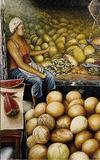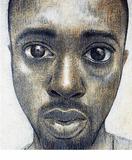

LEFT: Keble Johnson, 'Plummy Marketplace". RIGHT: Mabusha Dennis' untitled work copped top painting award.Jonathan Greenland, Contributor
Although sympathetic to popular culture, as an art historian I have been taught to be critical and discriminating. This is not always a good thing because that education can also turn you into an art snob, dismissive of anything that does not follow the respected canon of fine art.
So it was with some scepticism that I attended the opening of the National Visual Arts Competition (NVAC) and Exhibition hosted at the National Gallery in collaboration with the Jamaican Cultural Development Commission (JCDC).
Established in 1963, the NVAC attracts hundreds of entrants of mixed artistic abilities. For the first time, however, it was on view at the nation's premier institution for fine arts, a political milestone after decades of JCDC attempts to land a decent venue, and more specifically to get 'a foot in' the National Gallery's doors.
Immediately apparent at the opening was the optimism and excitement that the show's big audience seemed to generate.
A mixed crowd packed the lower gallery while hundreds more streamed upstairs, lining the mezzanine and stairways. This was unusual for the National Gallery where art lovers have grown accustomed to the same faces and sometimes even the predictable hybrid art.
Among the new visitors brought to the National Gallery were school children with parents, aspiring artists, friends, families and well-wishers decked out in their finest for the Sunday afternoon outing. After years of strategising how to get people into its space, the National Gallery suddenly found an exhibition it had historically neglected bringing the large audience it always wanted.
ENCOURAGEMENT
In keeping with the event's populist theme, Hon. Aloun Assamba, Minister of Tourism, Entertainment and Culture, reminded us of Prof. Rex Nettleford's caution that Jamaican art as manifested in the past century is too young to be overly discriminating. In opening the exhibition, the minister challenged institution builders to be as inclusive as possible and to be " ... encouraging, encouraging, encouraging."
Visitors waited impatiently for the security guards to 'fly the gate' so they could look at the inner galleries leading from the main halls. Many anxiously flipped through the exhibition's finely illustrated catalogue or stole glances at the photography and works by intuitive artists mounted upstairs.
The catalogue explained that 202 of the 424 entrants whose works were on display won awards ranging from merit certificates to bronze, silver and gold medals.
For those who might have questioned why some works had better rewards than others, the judges (reporting separately for both adult and children's sections) explained the challenges in evaluating such varied work and how entrants might improve submissions. Encouragement seemed to be the order of the day and the exhibition reflects a new era of collaboration and even compromise between the sometimes intimidating National Gallery entry rules and the moreopen-ended JCDC regulations.
With his expert eye, curator David Boxer did his usual expert job hanging this show, making the most of stronger works by showcasing them, and camouflaging weaker images with careful placement within subtle visual narratives. All the works benefited from simply being in the National Gallery's museum-like space. Careful hanging, lighting with professional labelling and cataloguing afforded them a status that enhanced their inherent qualities.
PRIDE
Given the integrity such expertise brought to their work, and the seriousness and rapt attention of viewers, the artists could only be proud. It's perhaps the same kind of pride found in the early days of Jamaica's independence when institutions such as the National Gallery were established.
The 'glasnost' between the gallery and our JCDC festival friends creates new issues, of course. Some believe this exhibition could compromise principles the gallery has fought to establish. Art connoisseurs may suggest that broadening access to the National Gallery will concede quality. This situation is not peculiar to our art institutions. The Royal Academy's Summer Show that opens its doors for one season to professionals and amateurs is one of London's most popular exhibits. Most critics, however, say that it is also crass. Such criticism is rooted in a mistrust of what the populace has to offer.
poor art education
In the case of Jamaican art, that fear has been linked to our poor art education and an ambivalence to our African roots. Tellingly, much of the work of NVAC, especially in the painting and youth sections, were far removed from Africa and replete with mundane still-life and nature themes that still reflects an insipid mimicking of European fine art traditions rather than a true expression of our own Caribbean cultural forms.
On the other hand, the photography on display is lively, experimental, innovative and sophisticated, suggesting that academic training is only one route to creative expression.
The lesson here isthat discriminatory practices while often upholding values can also stifle creativity.
Historically, photography has been a more accessible and popular medium than painting, sculpture, ceramic and fibre arts. The development of its point-and-click technology has meant that anyone fancying themselves as having a 'good eye' can capture an image without extensive art school training. As a result, this art form has been able to thrive outside artistic institutions, burgeoning in amateur camera clubs or hobby classes.
It is an art form that many art historians, curators and the art collectors have come to belatedly. Ironically, this neglect has created a liberating space where artists are free to experiment without censure. This is just as apparent in Jamaica's national competition as it might be elsewhere in the world.
Winners all
Mel Cooke, Freelance Writer
The applause from those gathered at Orange Park, downtown Kingston, was almost as consistent as the steady breeze from Kingston Harbour, the two occasionally picking up in intensity last Sunday.
And, as the Awards Presentation of the National Visual Arts Competition and Exhibition 2007 got into the sectional prizes, the gusts of stronger applause and cheers came closer together.
The presentation of medals and certificates, which came before, was an indication of the sectional prize winners. So it was no surprise that, after her gold and pair of silver, bronze and merit awards were announced in the presentation, Laura-Ann Fung was the first sectional prize winner, taking Promise Prize and $20,000 for the Most Outstanding Youth Exhibit.
St. Thomas took back-to-back prizes, art teacher at Seaforth High Carol Myers collecting the Summit Prize for the school with the richest awards tally. A gold medal counted for eight points, a silver for five, bronze got three and merit two. Seaforth ended up with four silver, eight bronze and 10 merit awards from the 10 students who entered. She was joined by Dwight Dawkins and Errol McKenzie, also from St. Thomas, to receive the Top Teacher trophy and $30,000.
Adult entries category
The person who submitted the best work in each category of adult entries received a trophy and $100,000, except for Fibre and Video Arts, where there were no awards. Carlene Goffe's 'Mi Love Dis' won the Ceramics prize, while both the top painting by Mabusha Dennis and and Leon's best Works on Paper were untitled. 'Windows' by Shanti Persaud was determined best in the Photography category and Michael Parchment's gold medal winning 'Ark of the Covenant' was best in Sculpture and Assemblage.
The final award presented in Orange Park last Sunday was the Viewers Award, determined by the ballots of those who had visited the exhibition at the National Gallery. Heather Grant, who hosted the awards, said that of 382 ballots submitted 56 were disqualified and 18 spoilt, leaving Laura-Ann Fung's gold medal 'Nature's Exaggeration' to take 102 of 308 votes. She won a trophy and $50,000.
The exhibition continues at the National Gallery, without an entry fee, until August 18, before it begins travelling across the island, beginning in September.

